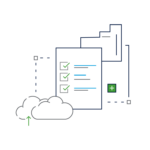Even though digitalisation is now a common part of most companies, there are still many myths and confusions associated with the term. In this article, we will look at the most common myths around digitalization that are holding back the progress of HR within companies and organizations.
1.Paper document is more reliable than electronic
It isn’t, this myth has arisen from ingrained habits and lack of information. According to the Czech legal system, an electronic document, i.e. a text recorded graphically, regardless of its form, is also a “document”. A properly created electronic document brings several advantages over the paper version:
- It ensures the integrity of the document, as any change is easily identifiable.
- It provides verifiable information about the author of the document, which is not so easy with paper documents.
- The use of a time stamp makes it clear when the document was created or signed, which is difficult to achieve with paper documents.
2. Our staff are not technically proficient and cannot handle
If employees can, for example, read an email, order a meal, communicate with an e-shop or bank from their mobile phone, they can also handle digital processes – for example, e-signing documents.
On the other hand, experience from companies shows a positive reception from employees who appreciate that they have constant access to their documents and, above all, can sign documents from anywhere and at any time. It does not matter whether they are at work, sick or on a business trip.
3. The digital document will not be accepted by the office
If you submit a paper document, the authorities will check for the presence of a stamp and signature or their authenticity. No one will check which cabinet the document was in and whether it was placed there by the correct procedure. It is the same with electronic documents. The legislative requirements concern the characteristics of documents, not the characteristics of archives.
The Regulation on electronic identification and trust services (e-IDAS) clearly states that it is not possible to reject a document simply because it is in electronic form, and the Regulation also takes precedence over any local legislation. In the real world, support for electronic documents or information recorded in electronic form is common.
4. The document cannot be emailed to the employee
This was previously the case, but with the amendment to the Labour Code this obstacle has fallen away. It is now possible for an employee to designate a private email address to which documents can be delivered. In addition, in the case of this method of service, the fiction of service with a fifteen-day period applies.
5. The control will take its revenge on us
It will not. The purpose of the official control is not to take the piss, but to verify the facts on the basis of the documents requested. As far as these documents are concerned, electronic and paper forms are equal before the law. You can agree with the auditor on a friendly basis to print out the contracts for practical reasons, but he has no legal right to do so.
6. We will have to replace the existing system with another
Digitalisation is not about coming in and destroying what you already have and starting to present you with new, complex challenges. Quite the opposite. Digitalisation is about leveraging what you already have and what you normally use. New elements are of course necessary, but the key is to improve, simplify your work and save time and money.
The main goal is to automate processes and add digital elements such as electronic signatures, digital document archives or electronic forms for government.
7. The electronic signature will expire and the contract will end
The validity of electronic elements (signatures, seals, stamps) on documents is really limited to one, three or six years. However, this does not mean that the whole document “expires” after the time period. It is important to distinguish between technical and legal validity. Even if technical certificates or signatures expire, the legal validity of the document remains unaffected – the contract remains valid, the agreement remains valid and the obligations and commitments remain in force.
What changes is the ability to prove the validity of the signature and your position in a lawsuit. If the signatures on the document are valid and, moreover, qualified, then you have clear evidence. However, if the signatures expire and you do not archive the documents in a trustworthy manner in accordance with the eIDAS Regulation, it may be more difficult for you to prove your position in litigation.
8. Scanning is already digitalisation
It is not, if you scan documents, then you also create them, send them out, select them, archive them and invest unnecessary time and work, the elimination of which is precisely the goal of digitizing HR processes. Saving the scanned document in the employee’s electronic file is the imaginary culmination of this process.
The goal of digitization is that paper documents are not created at all and you can trust the digital ones as much as the paper ones. Scanning brings a lot of tasks but only a minimum of benefits.
Digitization saves your time, reduces your operating costs and your carbon footprint.
We know that HR work is not about paperwork, it’s about taking care of employees. By automating HR processes, you save many hours of routine work.
Digitizing HR processes means having more time for everything, and we’re ready to show you how to achieve this freedom in your payroll and HR management.
At Nugget, we are intensively involved in this issue and we believe that thanks to our extensive experience in digitizing (not only) HR departments in companies of different sizes, we can be the right guide and partner for you on your way to a digitized HR department.







